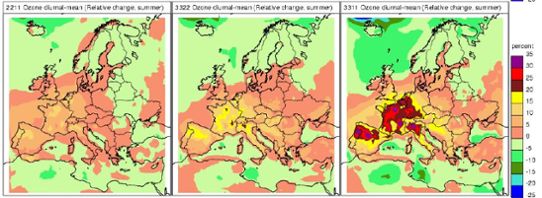Changes in emissions in Europe and the rest of the world have resulted in significantly changed concentrations and depositions over the past few decades. Changes in the climate can however also affect the Air Quality.
Climate impacts on Air Quality
Climate change can affect the Air Quality directly, for example through changed wind directions or changed precipitation patterns, which affect the levels of air pollutants in the ambient air.
Climate change can also indirectly affect the Air Quality through changes in human and natural emissions, for example through the changes in demand for heating/cooling in buildings and changes in natural emissions of many biogenic substances – which are often a function of meteorological parameters such as temperature and humidity.
Many processes, which impact on the level of air pollutants in the atmosphere, are dependent on meteorological conditions, for example:
- Transportation direction
- Wet deposition
- Chemical reactions
- Physical transformation
- Turbulent mixing
- Land-use change
Model results
The model calculations indicate that climate change are not expected to result in considerable changes to the quality of the air in northern Europe. Very noticeable changes can, however, be expected in central and southern Europe due to increased temperature, reduced precipitation and reduced cloud cover.

MATCH model
MATCH includes modules describing emissions, advection, turbulent mixing and dry and wet deposition. Depending on the application, specific modules describing, e.g., chemistry or aerosol dynamics can be added to the basic transport model. Atmospheric weather data are taken from a three-dimensional numerical weather prediction (NWP) model.
By making use of information from a high-resolution regional climate model as input data to MATCH, we can study the effects of climate changes in the air.
In the dispersion calculations, we have used the best estimation of today’s emissions and today’s background concentrations on the model boundaries. Emissions and background concentrations vary throughout the year, but they are kept the same for today’s climate and the climate in the future. Thus, the simulations differ in terms of the driving weather data (wind, temperature, precipitation etc.).The processes in the dispersion model which are dependent on the weather will react to these changes.
References and further reading
Engardt, M., Bergström, R. and Andersson, C. 2009. Climate and emission changes contributing to changes in near-surface ozone in Europe over the coming decades - Results from model studies. Ambio, in press.
Langner, J., Andersson, C. and Engardt, M. 2009. Atmospheric input of nitrogen to the Baltic Sea basin: present situation, variability due to meteorology and impact of climate change. Boreal Environ. Res. 14, 226-237.
Hole, L. and Engardt, M. 2008. Climate change impact on atmospheric nitrogen deposition in Northwestern Europe: A model study. Ambio 37, 9-17.
Langner, J., Bergström, R. and Foltescu, V. 2005. Impact of climate change on surface ozone and deposition of sulphur and nitrogen in Europe. Atmos. Environ. 39, 1129-1141.